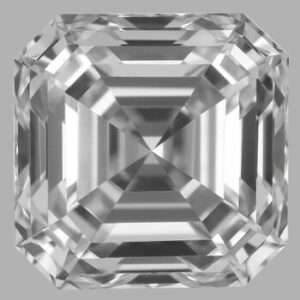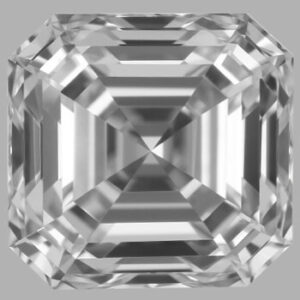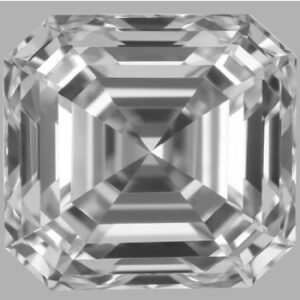Engagement Ring - In Progress
Setting
Stone
Purchase any Engagement Ring and receive a $250 Gift Card for your Wedding Band. Ends soon.
Deepen the well of love in the world.
The Royal Asscher Diamond Company faceted the first Asscher Cut Diamond in 1902. Although quite popular in early 1900s, Asscher Cuts are pretty uncommon today. In fact, at the time of writing, only about 0.7% of GIA-Certified Diamonds for sale globally were Asscher Cut (8,323 out of 1,178,007 diamonds). Unusual and elegant, Asscher Cut Engagement Rings give a beautiful, vintage engagement look.
Asscher Cuts are square-shaped gems with long, rectangular facets and clipped corners. Due to this unique faceting pattern, Asscher Cuts glimmer, like a hall of mirrors, as opposed to the traditional “sparkle” of round diamonds.
Like all other fancy cut diamonds, the GIA does not grade the cut quality of Asscher Diamonds. So, any jeweler who advertises an Asscher Cut with a cut grade is merely offering their own opinion. The stone’s GIA Certificate will not list a cut grade. For this reason, choosing a great Asscher Cut can be challenging. Furthermore, there is no industry standard of what makes an “Ideal Asscher Cut Diamond.” Because Do Amore strives to educate and help its customers, we provide our opinion on each of our Asscher’s cut grades. Here are the things to look for in a perfect asscher:
WINDMILL
The defining feature of an Asscher cut is its “windmill effect.” Beautiful windmill pattern provides a clear distinction between the stone’s “steps” and its corners. Below is a comparison of a beautiful windmill pattern, as compared with a stone without windmill distinction.


BLACK BOX
Another thing to consider is the pattern of your “contrast” (the dark areas within your stone). Choosing the nicest asscher cuts means staying away from stones with a distracting black box. Here is an example of a beautifully stepped asscher, next to a stone with a distracting black box:

Here are additional parameters that we recommend!
| IDEAL/EXCELLENT | PREMIUM | GOOD | |
| TABLE | 60-69 | 70-71 | 72+ |
| DEPTH | 60 – 67 | 68-70 | 71+ |
The color grade of an Asscher refers to how much yellow or brown tint (or lack of tint) the diamond shows. In general, Asschers reveal more color compared to other diamond shapes because its long facets do not mask color through traditional sparkle. Because warm candlelight was much more common in the early 1900’s, many Asscher Cut Engagement Rings from that time are warmer-toned colors like I and J. In contrast, with bright LEDs all around us today, many couples prefer colorless Asscher cuts for a whiter look.
Smaller Asschers mask color better than larger Asschers do. So, depending on the size of diamond, you may not need a colorless (D-F) diamond (even if you want your diamond to appear colorless). The color metal you choose also plays a role – warm toned metal (yellow or rose!) helps to hide diamond color.
Here is an example of an E colored Asscher, next to an I colored Asscher:


Here are our recommendations:
| WHITE METAL | YELLOW OR ROSE METAL | |
| >1ct | D-G | D-H |
| 1-2ct | D-F | D-G |
| 2+ct | D-E | D-F |
The clarity grade of an Asscher reflects how “crystal clear” the diamond is, or, in other words, the amount of birthmarks (“inclusions”) it has. How obvious these inclusions are informs which clarity grade a diamond receives. For example, a larger gem with a small inclusion will receive a better clarity grade than a smaller stone with the same size inclusion. This is because the inclusion is less noticeable in the larger stone.
However, because Asscher cuts do not sparkle the same way brilliant cut diamonds do, inclusions are easier to see in them. So, even a small inclusion is pretty obvious. As a result, couples choosing larger stones will mostly need to consider VVS1 or VVS2 grades for an eye-clean look. The clarity information below provides general guidelines for picking a clarity for your Asscher.
PRO TIP
Always have your jeweler check to confirm eye-clean appearance. We check every Asscher Cut Engagement Ring we sell and inform our couples if it is not eye clean. Because of Asscher’s unique faceting, the GIA Certificate is not enough!
Here is an example of a VS2 clarity asscher diamond next to a VVS2 clarity asscher:


Here is what we recommend:
| CLARITY | |
| >1ct | VS2+ |
| 1-2ct | VS1+ |
| 2+ct | VVS2+ |
All diamonds in our search engine have the length to width ratio listed. This ratio, which is simply the length divided by the width, determines how close to a perfect square the diamond is. In other words, a diamond with a 1.00 ratio means the diamond is a perfect square. However, most people view Asscher Cuts as visually square as long as the length to width ratio is 1.05 or less.
Check out the images below. Are you able to tell? It’s not obvious, but when you focus, you’ll see it. Especially when comparing the Asscher Cut with the 1.07 ratio vs the perfect Asscher Cut with the 1.00 ratio. We personally recommend Asschers with a length to width ratio of 1.03 or less, so that the stone looks like a perfectly symmetrical square.

1.00

1.04

1.07
Due to Asscher Cut’s broad proportion ranges, three Diamonds of the same carat weight can look and measure wildly differently. So, when looking for an Asscher Cut, use a very wide Carat Weight range (such as 1.20 to 1.70 for a carat and a half stone) in connection with our Recommended Proportions in your search. Then, look at each one for max measurements and beauty. You may find a better priced, bigger measuring Asscher Cut with a technically lighter carat weight than a more expensive, heavier stone that measures smaller! All diamonds in our “Recommended” stone section above have had their dimensions reviewed to make sure they were being maximized for their carat weight, while maintaining an ideal cut.
01.
Compare It - Use a wide Carat Weight range and Recommended Proportions to get the best bang for your buck!
02.
Photo & Video - Always ask the jeweler for a detailed picture or video. Check for windmill pattern and no black boxes!
03.
Inspect It - Ask the jeweler to physically see the diamond – visually inspect for symmetrical shine as you rock it back and forth.